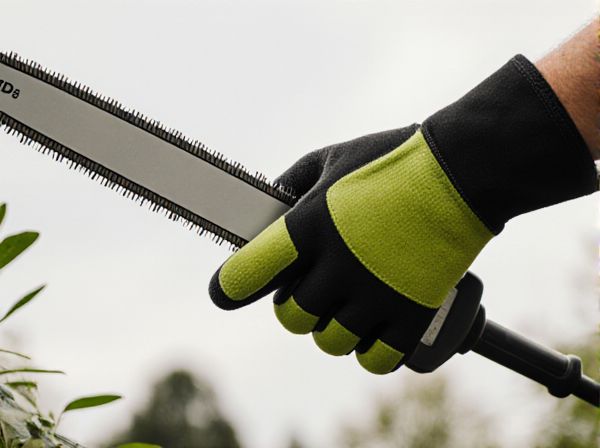
Pole Saw vs Pruning Saw Illustration
A pole saw offers extended reach for cutting high branches without the need for ladders, making it ideal for tall trees and hard-to-access limbs. A pruning saw, on the other hand, is handheld and better suited for precision cuts on smaller branches that require close control. Choosing between a pole saw and a pruning saw depends on the height and size of branches needing maintenance.
Table of Comparison
| Feature | Pole Saw | Pruning Saw |
|---|---|---|
| Purpose | Cutting high branches, hard-to-reach limbs | Trimming low branches, detailed pruning |
| Design | Long extendable pole with saw blade | Handheld, curved or straight blade |
| Reach | 10 to 15 feet or more | Typically under 2 feet |
| Cutting Capacity | Thick branches up to 8 inches | Small branches up to 2 inches |
| Power Source | Manual, electric, or gas-powered | Manual only |
| Weight | Light to medium, depends on model | Lightweight, easy to handle |
| Best For | Tree maintenance, safety in elevated cutting | Gardening, detailed trimming |
| Cost | Higher, due to mechanics and reach | Lower, simple manual tool |
Introduction to Pole Saws and Pruning Saws
Pole saws feature an extended handle designed to reach high branches, making them ideal for trimming tree limbs without the need for ladders. Pruning saws are handheld tools with a curved blade optimized for precision cutting of small to medium branches. Both tools are essential for effective tree maintenance, with pole saws suited for elevated cuts and pruning saws for detailed, close-up trimming.
Key Differences Between Pole Saws and Pruning Saws
Pole saws feature extended handles designed for cutting high branches without a ladder, offering increased reach and safety. Pruning saws have shorter blades and handles, optimized for precision cutting of smaller branches near ground level. The main differences lie in their length, cutting capacity, and intended use, with pole saws suited for overhead tasks and pruning saws ideal for close-up trimming.
Advantages of Using a Pole Saw
A pole saw offers superior reach and safety by allowing users to trim high branches without climbing ladders, reducing the risk of falls. Its telescoping handle provides adjustable length, enhancing control and efficiency when pruning tall trees. This tool is ideal for maintaining large yards and managing overgrown branches with minimal physical strain.
Benefits of a Pruning Saw for Gardeners
A pruning saw offers precise cutting capabilities essential for maintaining healthy plants and controlling growth in tight garden spaces. Its sharp, curved blade ensures clean cuts on thick branches without damaging surrounding foliage, promoting faster healing and reducing plant stress. Lightweight and easy to handle, pruning saws enhance maneuverability, making them ideal for gardeners managing intricate pruning tasks.
Suitable Tasks for Pole Saws
Pole saws are ideal for trimming high branches and limbs that are difficult to reach without a ladder, making them perfect for maintaining tall trees and large shrubs. Their extended handles allow users to prune overhead without climbing, enhancing safety and efficiency in yard maintenance. Best suited for light to moderate pruning, pole saws excel in cutting smaller branches up to 12 inches in diameter.
Ideal Uses for Pruning Saws
Pruning saws excel in cutting small to medium-sized branches ranging from 1 to 6 inches in diameter, making them ideal for detailed trimming and shaping of shrubs, trees, and garden plants. Their curved blades and sharp teeth enable precise cuts close to the branch collar, promoting healthy plant growth and minimizing damage. Pruning saws are particularly suited for gardeners and landscapers who require control and accuracy in confined spaces where larger tools like pole saws may be unwieldy.
Safety Considerations: Pole Saw vs Pruning Saw
Using a pole saw requires heightened safety measures due to its extended reach and potential for kickback, necessitating protective gear like helmets, gloves, and eye protection. Pruning saws, being handheld, offer greater control and reduced risk of injury but still demand caution, especially when cutting overhead or in tight spaces. Both tools benefit from secure footing and clear surroundings to prevent accidents during use.
Maintenance Requirements for Both Tools
Pole saws require regular cleaning of the blade and lubrication of the chain to prevent rust and ensure smooth operation, with frequent tension adjustments necessary for optimal cutting performance. Pruning saws demand consistent blade sharpening to maintain sharpness, and thorough cleaning after each use to avoid sap buildup that can dull the teeth. Both tools benefit from proper storage in dry conditions to prolong blade life and maintain cutting efficiency.
Factors to Consider When Choosing Between Pole Saw and Pruning Saw
Choosing between a pole saw and a pruning saw depends on factors such as the height and accessibility of branches, with pole saws ideal for tall or hard-to-reach limbs and pruning saws better suited for closer, more precise cuts. Consider the weight and maneuverability, as pole saws tend to be heavier and require more effort to control, while pruning saws are lighter and offer greater precision for detailed pruning tasks. Additionally, evaluate the type of vegetation, thickness of branches, and frequency of use to ensure the chosen tool matches the specific pruning requirements.
Conclusion: Which Tool Is Best for Your Gardening Needs?
Choosing between a pole saw and a pruning saw depends on the height and reach required for your gardening tasks; pole saws excel at trimming tall trees and hard-to-reach branches, while pruning saws offer precision for closer, detailed cutting. For gardeners managing large landscapes or tall trees, a lightweight, extendable pole saw with a sharp, durable blade provides efficiency and safety. Smaller gardens or intricate pruning benefit from the control and maneuverability of a pruning saw featuring ergonomic handles and fine-toothed blades.
Pole Saw vs Pruning Saw Infographic

 gardendif.com
gardendif.com